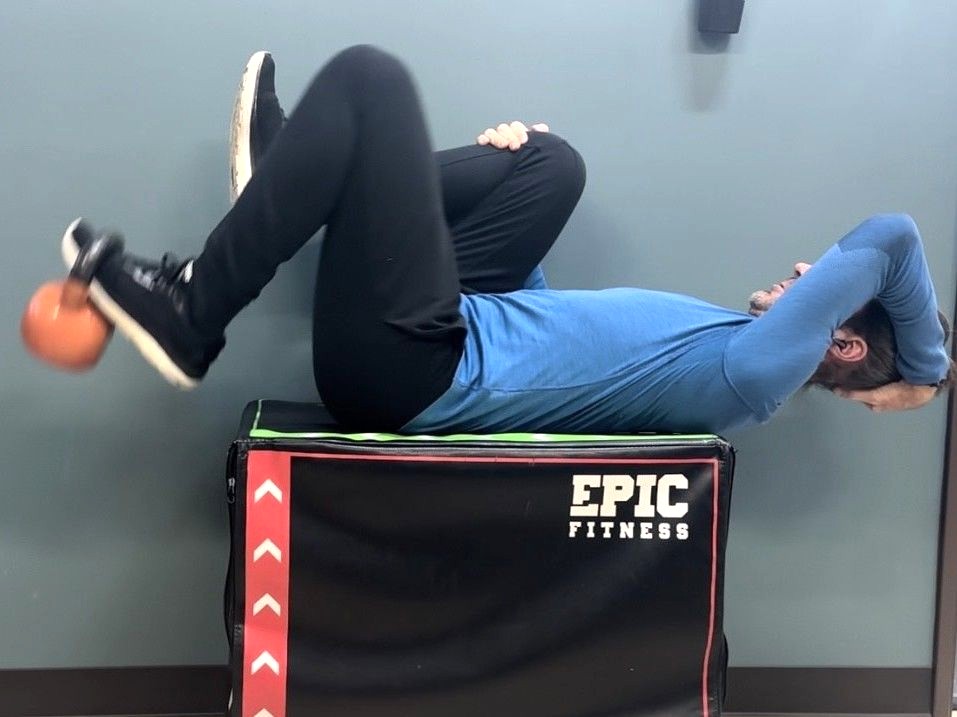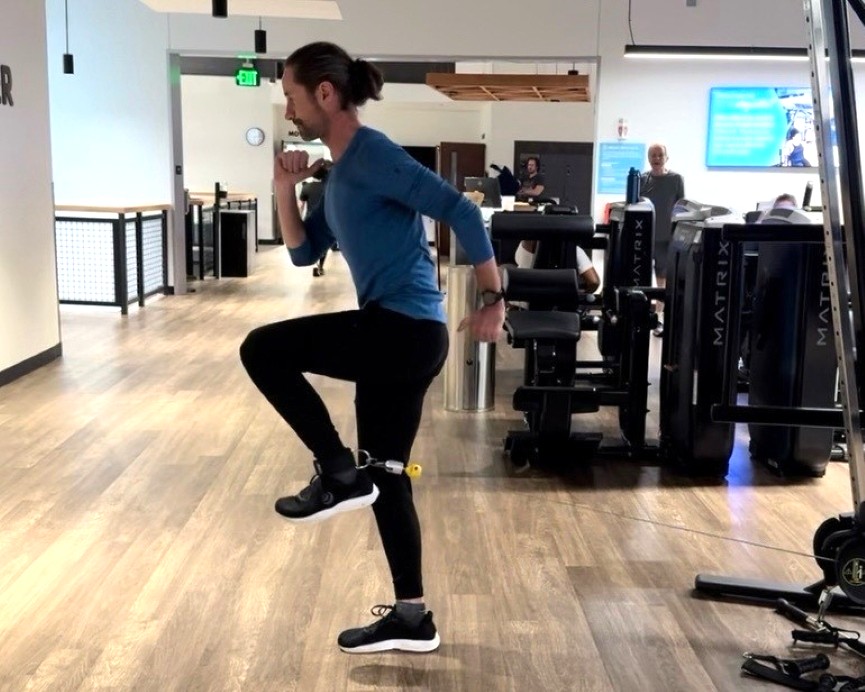 Hip flexion makes up half of the running motion. Strong hip flexors are the crucial upward-forward yin to the downward-rearward yang of powerful glutes that create hip extension.
Hip flexion makes up half of the running motion. Strong hip flexors are the crucial upward-forward yin to the downward-rearward yang of powerful glutes that create hip extension.
Previous articles have outlined both the importance and impact of hip flexion — and, when paired with hip extension, the resulting vertical hip strategy — on running efficiency and progressive ways to strengthen them.
However, as my study of running biomechanics has progressed, one key point impressed upon me is how and when we strengthen running muscles. At what point in the movement range do we apply resistance to get the best benefit?
Force application for strengthening depends on a few factors:
- The type of resistance: is it gravity, a band, a heavy weight, or a cable?
- The body position: is the runner supine, prone, sitting, or standing?
- The quality of resistance: is the resistance consistent or variable?
When analyzing most hip flexor and “ab” (abdominal/core stability) exercises, most only strengthen the anterior hip and trunk muscles in the middle or end ranges. In other words, the force is only applied when the hip is flexed up.
This may seem like many of us can build strong hip flexors and six-pack abs with tight bike pedals and banded hip flexor resistance. But that only covers a small — and for distance runners, a seldom-used — range of motion. According to the world’s best running stride coaches, the key range to develop a powerful hip flexion action is at the beginning range, when your leg is stretched back behind you, at the hip position just after push-off. Why? Because a strong hip flexor pull from this extended position optimizes three key aspects of stride efficiency: cadence, opposite leg glute push-off, and foot strike efficiency.

An efficient stride takes Lithuania’s Aleksandr Sorokin to winning the 2023 IAU 24-Hour World Championships. Photo: International Association of Ultrarunners
Three Running Stride Benefits from Early-Range Hip Flexor Strength
We can see three clear running stride benefits from developing hip flexor strength early in the muscles’ range of movement.
First, cadence. When your hip flexors, especially the psoas major, fire strongly from a fully extended hip, they snap your leg forward faster. As your foot leaves the ground behind you, a strong psoas contracts like a coiled spring, pulling your knee up and through without hesitation. A weak or delayed hip flexor action will drag the foot, often resulting in a sluggish, plodding stride.
Next, the opposite hip. When your hip flexors powerfully drive the trailing leg forward from extension, it creates an equal and opposite effect. They prime the glute max on your stance leg for a stronger and more complete push-off. Like a seesaw, as the hip flexor on one side pulls up with force, the glute on the other side slams down harder. A stronger psoas and rectus femoris in that stretched-out position amplify this effect, ensuring a maximization of glute-driven push-off.
Sprint coaches call this the scissor effect: where strong upward-forward hip flexors enhance a strong downward-rearward hip extension. The result? You’re not just floating along; you’re optimizing forward propulsion with every step, enhancing both top speed and uphill climbs, where power matters most.
Finally, there’s the landing pattern — where shoe rubber meets the trail. Overstriding is the enemy of efficiency; it bleeds energy and jars your muscles, bones, and joints. But when those hip flexors are strong in that early range, it enhances an efficient vertical hip action. The result of a stronger upward hip flexion action is a more tidy, compact movement cycle. Your foot lands beneath your center of mass, letting you roll through the stride with minimal waste.
Two Strategies for Early-Range Hip Flexor Strength
There are two strategies that work the hip flexor in its early range. They both involve a more consistent force applied to the hip flexors with the hip beginning in full extension.
[Editor’s Note: If you can’t see the film above, you can watch it at this link.]
Kettlebell Hip Flexion
This exercise uses a kettlebell hooked on the toes of the foot while lying on a high surface, such as a plyometric box. This higher height is important, as the strengthened leg must be allowed to fully extend at the hip.
To Perform
- Apply a kettlebell or Velcro cuff weight to the foot and ankle.
- Lie supine on a high surface, such as a massage table or plyometric box, at a height high enough to allow for the loaded hip to be fully extended. If the surface is too short, support your head and neck with one hand as shown.
- To support and lock out the movement of the lower back, flex and hold the opposite hip and knee with your other hand.
- Slowly flex the weighted foot and ankle upward through the full range. Note, once you pass 90 degrees of flexion, the resistance will decrease. Pause, then slowly lower.

The author demonstrating a kettlebell hip flexion with the weighted foot on the ground. Photo: Joe Uhan
Perform a weight that you can move without pain or strain for 5 to 10 repetitions. Perform 2 to 5 sets per leg.
Cable Hip Flexion
A cable or pulley machine also allows for consistent force application in an early range. As this exercise is performed in standing, it will also challenge the stance leg’s hip stability and core strength to maintain efficient, upright posture.
To Perform
- Lower the pulley system so it is at ground level.
- Apply a cloth cuff to the ankle.
- Walk out a couple steps until the cable becomes taught.
- Assume a running posture, with hip hinge and weighted leg extended.
- Flex the cable-connected foot and leg upward and forward. Maintain consistent running posture and, if possible, complement with a running arm swing.
- Pause one second at the top, then slowly return.
Perform a weight that you can move without pain or strain for 5 to 10 repetitions. Perform 2 to 5 sets per leg.
Conclusion
Strong hip flexors are a critical element in efficient running. To optimize their strength in a running-specific way, work ‘em in a lengthened position!
Call for Comments
Have you been working on your hip flexor strength? If so, have you noticed an impact on your running?




